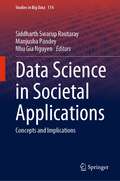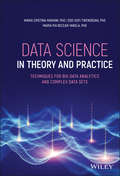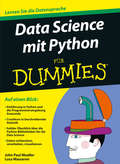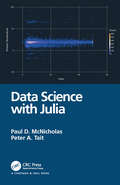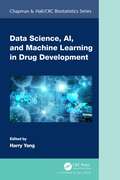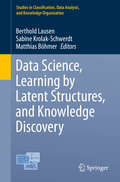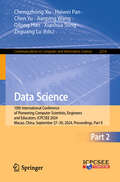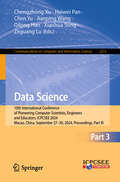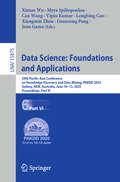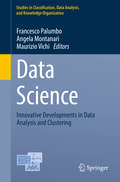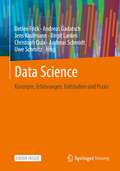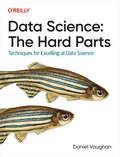- Table View
- List View
Data Science in Air Quality Monitoring (Engineering Applications of Computational Methods #23)
by Hui Liu Yanfei Li Zhu DuanThis book presents a series of state-of-the-art methods for air quality monitoring in various engineering environment by using data science. In the book, the data-driven key techniques of the preprocessing, decomposition, identification, clustering, forecasting and interpolation of the air quality monitoring are explained in details with lots of experimental simulation. The book can provide important reference for the development of data science technologies in engineering air quality monitoring. The book can be used for students, engineers, scientists and managers in the fields of environmental engineering, atmospheric science, urban climate, civil engineering, traffic and vehicle engineering, etc.
Data Science in Engineering, Volume 9: Proceedings of the 40th IMAC, A Conference and Exposition on Structural Dynamics 2022 (Conference Proceedings of the Society for Experimental Mechanics Series)
by Ramin Madarshahian Francois HemezData Science in Engineering, Volume 9: Proceedings of the 40th IMAC, A Conference and Exposition on Structural Dynamics, 2022, the nineth volume of nine from the Conference brings together contributions to this important area of research and engineering. The collection presents early findings and case studies on fundamental and applied aspects of Data Science in Engineering, including papers on:Novel Data-driven Analysis MethodsDeep Learning Gaussian Process AnalysisReal-time Video-based AnalysisApplications to Nonlinear Dynamics and Damage DetectionHigh-rate Structural Monitoring and Prognostics
Data Science in Practice (Chapman & Hall/CRC Data Science Series)
by Tom AlbyData Science in Practice is the ideal introduction to data science. With or without math skills, here, you get the all-round view that you need for your projects. This book describes how to properly question data, in order to unearth the treasure that data can be. You will get to know the relevant analysis methods, and will be introduced to the programming language R, which is ideally suited for data analysis. Associated tools like notebooks that make data science programming easily accessible are included in this introduction. Because technology alone is not enough, this book also deals with problems in project implementation, illuminates various fields of application, and does not forget to address ethical aspects. Data Science in Practice includes many examples, notes on errors, decision-making aids, and other practical tips. This book is ideal as a complementary text for university students, and is a useful learning tool for those moving into more data-related roles. Key Features: Success factors and tools for all project phases Includes application examples for various subject areas Introduces many aspects of Data Science, from requirements analysis to data acquisition and visualization
Data Science in R: A Case Studies Approach to Computational Reasoning and Problem Solving (Chapman And Hall/crc The R Ser. #26)
by Deborah Nolan Duncan Temple LangEffectively Access, Transform, Manipulate, Visualize, and Reason about Data and ComputationData Science in R: A Case Studies Approach to Computational Reasoning and Problem Solving illustrates the details involved in solving real computational problems encountered in data analysis. It reveals the dynamic and iterative process by which data analysts
Data Science in Societal Applications: Concepts and Implications (Studies in Big Data #114)
by Nhu Gia Nguyen Siddharth Swarup Rautaray Manjusha PandeyThe book provides an insight into the practical applications and theoretical foundation of data science. The book discusses new ways of embracing agile approaches to various facets of data science, including machine learning and artificial intelligence, data mining, data visualization, and communication. The book includes contributions from academia and industry experts detailing the shortfalls of current tools and techniques used and generating the blueprint of the new technologies. The topics covered in the book range from theoretical and foundational research, platforms, methods, applications, and tools in data science. The chapters in the book add a social, geographical, and temporal dimension to data science research. The papers included are application-oriented that prepare and use data in discovery research. This book will provide researchers and practitioners with a detailed snapshot of current progress in data science. Moreover, it will stimulate new study, research, and the development of new applications.
Data Science in Theory and Practice: Techniques for Big Data Analytics and Complex Data Sets
by Maria Cristina Mariani Osei Kofi Tweneboah Maria Pia Beccar-VarelaDATA SCIENCE IN THEORY AND PRACTICE EXPLORE THE FOUNDATIONS OF DATA SCIENCE WITH THIS INSIGHTFUL NEW RESOURCE Data Science in Theory and Practice delivers a comprehensive treatment of the mathematical and statistical models useful for analyzing data sets arising in various disciplines, like banking, finance, health care, bioinformatics, security, education, and social services. Written in five parts, the book examines some of the most commonly used and fundamental mathematical and statistical concepts that form the basis of data science. The authors go on to analyze various data transformation techniques useful for extracting information from raw data, long memory behavior, and predictive modeling. The book offers readers a multitude of topics all relevant to the analysis of complex data sets. Along with a robust exploration of the theory underpinning data science, it contains numerous applications to specific and practical problems. The book also provides examples of code algorithms in R and Python and provides pseudo-algorithms to port the code to any other language. Ideal for students and practitioners without a strong background in data science, readers will also learn from topics like: Analyses of foundational theoretical subjects, including the history of data science, matrix algebra and random vectors, and multivariate analysis A comprehensive examination of time series forecasting, including the different components of time series and transformations to achieve stationarity Introductions to both the R and Python programming languages, including basic data types and sample manipulations for both languages An exploration of algorithms, including how to write one and how to perform an asymptotic analysis A comprehensive discussion of several techniques for analyzing and predicting complex data sets Perfect for advanced undergraduate and graduate students in Data Science, Business Analytics, and Statistics programs, Data Science in Theory and Practice will also earn a place in the libraries of practicing data scientists, data and business analysts, and statisticians in the private sector, government, and academia.
Data Science mit Python für Dummies (Für Dummies)
by John Paul Mueller Luca MassaronSie wollen sich ernsthaft mit wissenschaftlicher Datenanalyse beschäftigen und wissen, dass Sie da an Python nur schwer vorbeikommen? Dann ist dieses das richtige Buch für Sie. John Paul Mueller erklärt Ihnen, was Sie in Python beherrschen müssen, um sich der Datenanalyse zu widmen inklusive Objekten, Funktionen, Modulen und Bibliotheken. Außerdem erläutert er die wichtigsten Bibliotheken für die Datenanalyse wie NumPy, SciPy, BeautifulSoup, Pandas, und MatPlobLib. So lernen Sie Python für die Datenanalyse richtig einsetzen.
Data Science und Statistik mit R: Anwendungslösungen für die Praxis
by Bernd HeesenData Science trägt wesentlich zu einer schnelleren Nutzbarmachung von Markt-, Kunden- und Nutzerdaten bei, inklusive der Analyse von Daten aus Sozialen Netzwerken. Wo früher klassische Statistik für Berechnungen und Vorhersagen herangezogen wurde, da erlauben heute Open-Source-Werkzeuge wie R Daten in unterschiedlichsten Formaten und aus beliebig vielen Quellen für die Analyse einzulesen, aufzubereiten und mit Hilfe von Methoden der Künstlichen Intelligenz und des Machine Learning zu analysieren. Die Ergebnisse können dann anschließend perfekt visuell dargestellt werden, so dass die Entscheider schnell und effektiv davon profitieren können. Daraus lässt sich ableiten, welche Maßnahmen mit einer vorhersagbaren Wahrscheinlichkeit zur Erreichung der eigenen Ziele geeignet sind, z.B. welcher Preis für ein Angebot die gewünschte Nachfrage erzeugt oder welche Marketingmaßnahme eine gewünschte Zielgruppe erreicht.Dieses Buch vermittelt auf Basis von R, wie Sie Statistik, Data Science, Künstliche Intelligenz und Machine Learning in der Industrie 4.0 nutzen können. Die Anwendungsbeispiele können von Lesern selbst durchgeführt werden, da das Buch die R-Anweisungen beinhaltet. Damit ist das Buch ideal für Studierende und andere Interessierte, die sich Kenntnisse in der Statistiklösung R aneignen wollen.
Data Science with Julia
by Peter Tait Paul McNicholas"This book is a great way to both start learning data science through the promising Julia language and to become an efficient data scientist."- Professor Charles Bouveyron, INRIA Chair in Data Science, Université Côte d’Azur, Nice, France Julia, an open-source programming language, was created to be as easy to use as languages such as R and Python while also as fast as C and Fortran. An accessible, intuitive, and highly efficient base language with speed that exceeds R and Python, makes Julia a formidable language for data science. Using well known data science methods that will motivate the reader, Data Science with Julia will get readers up to speed on key features of the Julia language and illustrate its facilities for data science and machine learning work. Features: Covers the core components of Julia as well as packages relevant to the input, manipulation and representation of data. Discusses several important topics in data science including supervised and unsupervised learning. Reviews data visualization using the Gadfly package, which was designed to emulate the very popular ggplot2 package in R. Readers will learn how to make many common plots and how to visualize model results. Presents how to optimize Julia code for performance. Will be an ideal source for people who already know R and want to learn how to use Julia (though no previous knowledge of R or any other programming language is required). The advantages of Julia for data science cannot be understated. Besides speed and ease of use, there are already over 1,900 packages available and Julia can interface (either directly or through packages) with libraries written in R, Python, Matlab, C, C++ or Fortran. The book is for senior undergraduates, beginning graduate students, or practicing data scientists who want to learn how to use Julia for data science. "This book is a great way to both start learning data science through the promising Julia language and to become an efficient data scientist." Professor Charles BouveyronINRIA Chair in Data ScienceUniversité Côte d’Azur, Nice, France
Data Science with R for Psychologists and Healthcare Professionals
by Christian RyanThis introduction to R for students of psychology and health sciences aims to fast-track the reader through some of the most difficult aspects of learning to do data analysis and statistics. It demonstrates the benefits for reproducibility and reliability of using a programming language over commercial software packages such as SPSS. The early chapters build at a gentle pace, to give the reader confidence in moving from a point-and-click software environment, to the more robust and reliable world of statistical coding. This is a thoroughly modern and up-to-date approach using RStudio and the tidyverse. A range of R packages relevant to psychological research are discussed in detail. A great deal of research in the health sciences concerns questionnaire data, which may require recoding, aggregation and transformation before quantitative techniques and statistical analysis can be applied. R offers many useful and transparent functions to process data and check psychometric properties. These are illustrated in detail, along with a wide range of tools R affords for data visualisation. Many introductory statistics books for the health sciences rely on toy examples - in contrast, this book benefits from utilising open datasets from published psychological studies, to both motivate and demonstrate the transition from data manipulation and analysis to published report. R Markdown is becoming the preferred method for communicating in the open science community. This book also covers the detail of how to integrate the use of R Markdown documents into the research workflow and how to use these in preparing manuscripts for publication, adhering to the latest APA style guidelines.
Data Science – was ist das eigentlich?!: Algorithmen des maschinellen Lernens verständlich erklärt
by Annalyn Ng Kenneth SooSie möchten endlich wissen, was sich hinter Schlagworten wie „Data Science“ und „Machine Learning“ eigentlich verbirgt – und was man alles damit anstellen kann? Auf allzu viel Mathematik würden Sie dabei aber gern verzichten? Dann sind Sie hier genau richtig: Dieses Buch bietet einen kompakten Einblick in die wichtigsten Schlüsselkonzepte der Datenwissenschaft und ihrer Algorithmen – und zwar ohne Sie mit mathematischen Formeln und Details zu belasten! Der Fokus liegt – nach einer übergeordneten Einführung – auf Anwendungen des maschinellen Lernens zur Mustererkennung und Vorhersage von Ergebnissen: In jedem Kapitel wird ein Algorithmus erläutert und mit einem leicht verständlichen, realen Anwendungsbeispiel verknüpft. Die Kombination aus intuitiven Erklärungen und zahlreichen Abbildungen ermöglicht dabei ein grundlegendes Verständnis, das ohne mathematische Formelsprache auskommt. Abschließend werden auch die Grenzen und Nachteile der betrachteten Algorithmen explizit aufgezeigt.
Data Science, AI, and Machine Learning in Drug Development (Chapman & Hall/CRC Biostatistics Series)
by Harry YangThe confluence of big data, artificial intelligence (AI), and machine learning (ML) has led to a paradigm shift in how innovative medicines are developed and healthcare delivered. To fully capitalize on these technological advances, it is essential to systematically harness data from diverse sources and leverage digital technologies and advanced analytics to enable data-driven decisions. Data science stands at a unique moment of opportunity to lead such a transformative change. Intended to be a single source of information, Data Science, AI, and Machine Learning in Drug Research and Development covers a wide range of topics on the changing landscape of drug R & D, emerging applications of big data, AI and ML in drug development, and the build of robust data science organizations to drive biopharmaceutical digital transformations. Features Provides a comprehensive review of challenges and opportunities as related to the applications of big data, AI, and ML in the entire spectrum of drug R & D Discusses regulatory developments in leveraging big data and advanced analytics in drug review and approval Offers a balanced approach to data science organization build Presents real-world examples of AI-powered solutions to a host of issues in the lifecycle of drug development Affords sufficient context for each problem and provides a detailed description of solutions suitable for practitioners with limited data science expertise
Data Science, Learning by Latent Structures, and Knowledge Discovery (Studies in Classification, Data Analysis, and Knowledge Organization)
by Berthold Lausen Sabine Krolak-Schwerdt Matthias BöhmerThis volume comprises papers dedicated to data science and the extraction of knowledge from many types of data: structural, quantitative, or statistical approaches for the analysis of data; advances in classification, clustering and pattern recognition methods; strategies for modeling complex data and mining large data sets; applications of advanced methods in specific domains of practice. The contributions offer interesting applications to various disciplines such as psychology, biology, medical and health sciences; economics, marketing, banking and finance; engineering; geography and geology; archeology, sociology, educational sciences, linguistics and musicology; library science. The book contains the selected and peer-reviewed papers presented during the European Conference on Data Analysis (ECDA 2013) which was jointly held by the German Classification Society (GfKl) and the French-speaking Classification Society (SFC) in July 2013 at the University of Luxembourg.
Data Science: 10th International Conference of Pioneering Computer Scientists, Engineers and Educators, ICPCSEE 2024, Macao, China, September 27–30, 2024, Proceedings, Part I (Communications in Computer and Information Science #2213)
by Qilong Han Xianhua Song Zeguang Lu Chen Yu Jianping Wang Chengzhong Xu Haiwei PanThis three-volume set CCIS 2213-2215 constitutes the refereed proceedings of the 10th International Conference of Pioneering Computer Scientists, Engineers and Educators, ICPCSEE 2024, held in Macau, China, during September 27–30, 2024. The 74 full papers and 3 short papers presented in these three volumes were carefully reviewed and selected from 249 submissions. The papers are organized in the following topical sections: Part I: Novel methods or tools used in big data and its applications; applications of data science. Part II: Education research, methods and materials for data science and engine; data security and privacy; big data mining and knowledge management. Part III: Infrastructure for data science; social media and recommendation system; multimedia data management and analysis.
Data Science: 10th International Conference of Pioneering Computer Scientists, Engineers and Educators, ICPCSEE 2024, Macao, China, September 27–30, 2024, Proceedings, Part II (Communications in Computer and Information Science #2214)
by Qilong Han Xianhua Song Zeguang Lu Chen Yu Jianping Wang Chengzhong Xu Haiwei PanThis three-volume set CCIS 2213-2215 constitutes the refereed proceedings of the 10th International Conference of Pioneering Computer Scientists, Engineers and Educators, ICPCSEE 2024, held in Macau, China, during September 27–30, 2024. The 74 full papers and 3 short papers presented in these three volumes were carefully reviewed and selected from 249 submissions. The papers are organized in the following topical sections: Part I: Novel methods or tools used in big data and its applications; applications of data science. Part II: Education research, methods and materials for data science and engine; data security and privacy; big data mining and knowledge management. Part III: Infrastructure for data science; social media and recommendation system; multimedia data management and analysis.
Data Science: 10th International Conference of Pioneering Computer Scientists, Engineers and Educators, ICPCSEE 2024, Macao, China, September 27–30, 2024, Proceedings, Part III (Communications in Computer and Information Science #2215)
by Qilong Han Xianhua Song Zeguang Lu Chen Yu Jianping Wang Chengzhong Xu Haiwei PanThis three-volume set CCIS 2213-2215 constitutes the refereed proceedings of the 10th International Conference of Pioneering Computer Scientists, Engineers and Educators, ICPCSEE 2024, held in Macau, China, during September 27–30, 2024. The 74 full papers and 3 short papers presented in these three volumes were carefully reviewed and selected from 249 submissions. The papers are organized in the following topical sections: Part I: Novel methods or tools used in big data and its applications; applications of data science. Part II: Education research, methods and materials for data science and engine; data security and privacy; big data mining and knowledge management. Part III: Infrastructure for data science; social media and recommendation system; multimedia data management and analysis.
Data Science: 29th Pacific-Asia Conference on Knowledge Discovery and Data Mining, PAKDD 2025, Sydney, NSW, Australia, June 10-13, 2025, Proceedings, Part VI (Lecture Notes in Computer Science #15875)
by Longbing Cao Myra Spiliopoulou Vipin Kumar Can Wang Joao Gama Xintao Wu Xiangmin Zhou Guansong PangThe two-volume set LNAI 15875 + 15876 constitutes the proceedings of the 29th Pacific-Asia Conference on Knowledge Discovery and Data Mining, PAKDD 2025 Special Session, held in Sydney, NSW, Australia, during June 10–13, 2025. The 68 full papers included in this set were carefully reviewed and selected from 696 submissions. They were organized in topical sections as follows: survey track; machine learning; trustworthiness; learning on complex data; graph mining; machine learning applications; representation learning; scientific/business data analysis; and special track on large language models.
Data Science: 29th Pacific-Asia Conference on Knowledge Discovery and Data Mining, PAKDD 2025, Sydney, NSW, Australia, June 10-13, 2025, Proceedings, Part VII (Lecture Notes in Computer Science #15876)
by Longbing Cao Myra Spiliopoulou Vipin Kumar Can Wang Joao Gama Xintao Wu Xiangmin Zhou Guansong PangThe two-volume set LNAI 15875 + 15876 constitutes the proceedings of the 29th Pacific-Asia Conference on Knowledge Discovery and Data Mining, PAKDD 2025 Special Session, held in Sydney, NSW, Australia, during June 10–13, 2025. The 68 full papers included in this set were carefully reviewed and selected from 696 submissions. They were organized in topical sections as follows: survey track; machine learning; trustworthiness; learning on complex data; graph mining; machine learning applications; representation learning; scientific/business data analysis; and special track on large language models.
Data Science: A First Introduction (Chapman & Hall/CRC Data Science Series)
by Tiffany Timbers Trevor Campbell Melissa LeeData Science: A First Introduction focuses on using the R programming language in Jupyter notebooks to perform data manipulation and cleaning, create effective visualizations, and extract insights from data using classification, regression, clustering, and inference. The text emphasizes workflows that are clear, reproducible, and shareable, and includes coverage of the basics of version control. All source code is available online, demonstrating the use of good reproducible project workflows. Based on educational research and active learning principles, the book uses a modern approach to R and includes accompanying autograded Jupyter worksheets for interactive, self-directed learning. The book will leave readers well-prepared for data science projects. The book is designed for learners from all disciplines with minimal prior knowledge of mathematics and programming. The authors have honed the material through years of experience teaching thousands of undergraduates in the University of British Columbia’s DSCI100: Introduction to Data Science course.
Data Science: A First Introduction with Python (Chapman & Hall/CRC Data Science Series)
by Joel Ostblom Tiffany Timbers Trevor Campbell Melissa Lee Lindsey HeagyData Science: A First Introduction with Python focuses on using the Python programming language in Jupyter notebooks to perform data manipulation and cleaning, create effective visualizations, and extract insights from data using classification, regression, clustering, and inference. It emphasizes workflows that are clear, reproducible, and shareable, and includes coverage of the basics of version control. Based on educational research and active learning principles, the book uses a modern approach to Python and includes accompanying autograded Jupyter worksheets for interactive, self-directed learning. The text will leave readers well-prepared for data science projects. It is designed for learners from all disciplines with minimal prior knowledge of mathematics and programming. The authors have honed the material through years of experience teaching thousands of undergraduates at the University of British Columbia.Key Features: Includes autograded worksheets for interactive, self-directed learning. Introduces readers to modern data analysis and workflow tools such as Jupyter notebooks and GitHub, and covers cutting-edge data analysis and manipulation Python libraries such as pandas, scikit-learn, and altair. Is designed for a broad audience of learners from all backgrounds and disciplines.
Data Science: Best Practices mit Python
by Benjamin M. Abdel-KarimDieses Buch entstand aus der Motivation heraus, eines der ersten deutschsprachigen Nachschlagewerke zu entwickeln, in welchem relativ simple Quellcode-Beispiele enthalten sind, um so Lösungsansätze für die (wiederkehrenden) Programmierprobleme in der Datenanalyse weiterzugeben. Dabei ist dieses Werk nicht uneigennützig verfasst worden. Es enthält Lösungswege für immer wiederkehrende Problemstellungen die ich über meinen täglichen Umgang entwickelt habe Zweifellos gehört das Nachschlagen von Lösungsansätzen in Büchern oder im Internet zur normalen Arbeit eines Programmierers. Allerdings ist diese Suche in der Regel ein unstrukturierter und damit, zumindest teilweise, ein zeitaufwendiger Prozess.Unabhängig davon, ob Sie das Buch als Student, Mitarbeiter oder Gründer lesen, hoffe ich, dass Ihnen dieses Nachschlagewerk ein wertvoller Helfer für die ersten Anfänge sein wird. Ich gehe davon aus, dass jede Person die Grundlagen der Datenanalyse mit Hilfe moderner Programmiersprachen erlernen kann.
Data Science: Innovative Developments in Data Analysis and Clustering (Studies in Classification, Data Analysis, and Knowledge Organization)
by Francesco Palumbo Angela Montanari Maurizio VichiInternational Federation of Classification Societies The International Federation of Classification Societies (lFCS) is an agency for the dissemination of technical and scientific information concerning classification and multivariate data analysis in the broad sense and in as wide a range of applications as possible; founded in 1985 in Cambridge (UK) by the following Scientific Societies and Groups: - British Classification Society - BCS - Classification Society of North America - CSNA - Gesellschaft fUr Klassification - GfKI - Japanese Classification Society - JCS - Classification Group ofItalian Statistical Society - CGSIS - Societe Francophone de Classification - SFC Now the IFCS includes also the following Societies: - Dutch-Belgian Classification Society - VOC - Polish Classification Section - SKAD - Portuguese Classification Association - CLAD - Group at Large - Korean Classification Society - KCS IFCS-98, the Sixth Conference of the International Federation of Classification Societies, was held in Rome, from July 21 to 24, 1998. Five preceding conferences were held in Aachen (Germany), Charlottesville (USA), Edinburgh (UK), Paris (France), Kobe (Japan).
Data Science: Konzepte, Erfahrungen, Fallstudien und Praxis
by Andreas Gadatsch Andreas Schmidt Christoph Quix Uwe Schmitz Detlev Frick Jens Kaufmann Birgit LankesData Science ist in vielen Organisationen angekommen und oft alltägliche Praxis. Dennoch stehen viele Verantwortliche vor der Herausforderung, sich erstmalig mit konkreten Fragestellungen zu beschäftigen oder laufende Projekte weiterzuentwickeln. Die Spannbreite der Methoden, Werkzeuge und Anwendungsmöglichkeiten ist sehr groß und entwickelt sich kontinuierlich weiter. Die Vielzahl an Publikationen zu Data Science ist spezialisiert und behandelt fokussiert Einzelaspekte. Das vorliegende Werk gibt den Leserinnen und Lesern eine umfassende Orientierung zum Status Quo aus der wissenschaftlichen Perspektive und zahlreiche vertiefende Darstellungen praxisrelevanter Aspekte. Die Inhalte bauen auf den wissenschaftlichen CAS-Zertifikatskursen zu Big Data und Data Science der Hochschule Niederrhein in Kooperation mit der Hochschule Bonn-Rhein-Sieg und der FH Dortmund auf. Sie berücksichtigen wissenschaftliche Grundlagen und Vertiefungen, aber auch konkrete Erfahrungen aus Data Science Projekten. Das Buch greift praxisrelevante Fragen auf wissenschaftlichem Niveau aus Sicht der Rollen eines „Data Strategist“, „Data Architect“ und „Data Analyst“ auf und bindet erprobte Praxiserfahrungen u. a. von Seminarteilnehmern mit ein. Das Buch gibt für Interessierte einen Einblick in die aktuell relevante Vielfalt der Aspekte zu Data Science bzw. Big Data und liefert Hinweise für die praxisnahe Umsetzung.
Data Science: Techniques for Excelling at Data Science
by Daniel VaughanThis practical guide provides a collection of techniques and best practices that are generally overlooked in most data engineering and data science pedagogy. A common misconception is that great data scientists are experts in the "big themes" of the discipline—machine learning and programming. But most of the time, these tools can only take us so far. In practice, the smaller tools and skills really separate a great data scientist from a not-so-great one.Taken as a whole, the lessons in this book make the difference between an average data scientist candidate and a qualified data scientist working in the field. Author Daniel Vaughan has collected, extended, and used these skills to create value and train data scientists from different companies and industries.With this book, you will:Understand how data science creates valueDeliver compelling narratives to sell your data science projectBuild a business case using unit economics principlesCreate new features for a ML model using storytellingLearn how to decompose KPIsPerform growth decompositions to find root causes for changes in a metricDaniel Vaughan is head of data at Clip, the leading paytech company in Mexico. He's the author of Analytical Skills for AI and Data Science (O'Reilly).
Data Science: The Executive Summary - A Technical Book for Non-Technical Professionals
by Field CadyTap into the power of data science with this comprehensive resource for non-technical professionals Data Science: The Executive Summary – A Technical Book for Non-Technical Professionals is a comprehensive resource for people in non-engineer roles who want to fully understand data science and analytics concepts. Accomplished data scientist and author Field Cady describes both the “business side” of data science, including what problems it solves and how it fits into an organization, and the technical side, including analytical techniques and key technologies. Data Science: The Executive Summary covers topics like: Assessing whether your organization needs data scientists, and what to look for when hiring them When Big Data is the best approach to use for a project, and when it actually ties analysts’ hands Cutting edge Artificial Intelligence, as well as classical approaches that work better for many problems How many techniques rely on dubious mathematical idealizations, and when you can work around them Perfect for executives who make critical decisions based on data science and analytics, as well as mangers who hire and assess the work of data scientists, Data Science: The Executive Summary also belongs on the bookshelves of salespeople and marketers who need to explain what a data analytics product does. Finally, data scientists themselves will improve their technical work with insights into the goals and constraints of the business situation.




